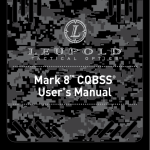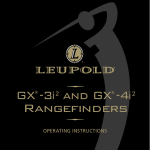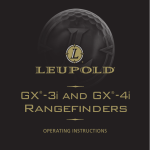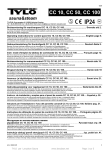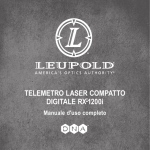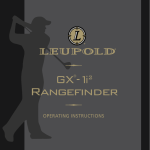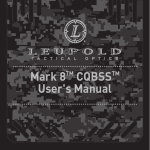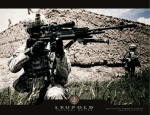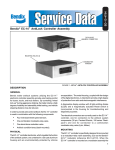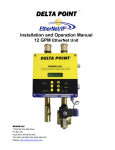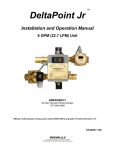Download HAMRTM (High Accuracy Multi-Range) 4x24mm
Transcript
HAMRTM (High Accuracy Multi-Range) 4x24mm Riflescope User's Manual www.leupold.com Part# 113492 Artwork# 113491 Table of Contents Know Your Scope . . . . . . . . . . . . . . . . . . . . . . . . . . . . . . . . . . . . . . . . . . . . . . Page 2 Installing a DeltaPointTM and Protective Shroud . . . . . . . . . . . . . . . . . . . . . Page 4 Mounting the Scope . . . . . . . . . . . . . . . . . . . . . . . . . . . . . . . . . . . . . . . . . . . . Page 6 Making Precise Elevation and Windage Adjustments . . . . . . . . . . . . . . . Page 11 How to Sight-In . . . . . . . . . . . . . . . . . . . . . . . . . . . . . . . . . . . . . . . . . . . . . . . Page 14 Using the Illumination . . . . . . . . . . . . . . . . . . . . . . . . . . . . . . . . . . . . . . . . . Page 18 Changing the Battery . . . . . . . . . . . . . . . . . . . . . . . . . . . . . . . . . . . . . . . . . . Page 20 Leupold Means Minimal Maintenance . . . . . . . . . . . . . . . . . . . . . . . . . . . . Page 23 Leupold Product Service . . . . . . . . . . . . . . . . . . . . . . . . . . . . . . . . . . . . . . . . Page 27 Know Your Scope 9 7 8 4 3 2 1 5 1. 2. 3. 4. 5. 6. Ocular Lens Diopter Adjustment Ring Diopter Lock Ring Elevation Adjustment Screw Windage Adjustment Screw Illumination Control Dial (Right Side of Scope) 7. 8. 9. DeltaPoint Sight Objective Lens DeltaPoint Protective Shroud 6 2 3 Riflescopes have become far more sophisticated over the years, but the four most basic parts have remained the same. Working from front to back they are: 1. The objective lens (or front lens) is critical to a superior sight picture. 2. The reticle, often referred to as the crosshair, provides the aiming point. 3. The internal erector lenses or prism which rights the image. 4. The ocular lens (or eyepiece lens) works with the other lenses to magnify the image, provide correct eye relief, and make diopter corrections. How Scopes Work As light passes through and beyond the objective lens, the resulting upside down image is sent to the internal prism which returns the image to a rightside-up position. Finally, the ocular lens makes a final enlargement of that image and sends it on to your eye. Your Leupold scope was designed, manufactured, and tested to ensure that, when properly mounted and sighted-in on your firearm, you will enjoy exceptional performance. A solid mount is critical to satisfactory performance of your scope. If you have questions or concerns, please contact Leupold Product Service (see page 27). Installing a Leupold DeltaPoint™ and the Protective Shroud For optimum performance and to prevent damage to the DeltaPoint, carefully read and follow the entire DeltaPoint instruction manual prior to installation or use. The HAMR is packaged in such a manner as to allow the immediate installation of a Leupold DeltaPoint. If you do not plan to install a DeltaPoint on top of the HAMR, placing the plastic protecive guard over the DeltaPoint mounting area is recommended. To install a DeltaPoint on top of the HAMR once the guard has been installed, you must first remove the plastic protective guard from the top of the HAMR by lifting one side, or gently prying with a screwdriver while using caution not to scratch the body of the HAMR. 4 5 Once the protective guard has been removed, consult the Start-Up, Battery Installation, and Installation sections outlined in the DeltaPoint Mounting & Operation Instructions. The DeltaPoint will attach directly to the top of the HAMR as shown to the right, using two M4x0.7mm screws (included). Warning: Screw torque must not exceed 20 inch/lbs as the DeltaPoint or HAMR may be damaged if excessive torque is applied. To install the protective shroud, simply slide it into place from the front of the HAMR until each of the screw holes are aligned, then secure each of the six 8-40 screws with the included T-15 Torx wrench. Warning: Screw torque must not exceed 20 inch/lbs as the HAMR may be damaged if excessive torque is applied. Mounting the Scope FLAT-TOP MOUNTING PROCEDURE Preparing the Leupold HAMR 4x24mm scope for flat-top (MIL-STD-1913) mounting: 1. Loosen the 1/2-inch hex nuts of the Mark 4 Base until they are near the end of its cross bolts. 2. Using the two 1/4-32 hex-head screws, attach HAMR to the Mark 4 Base using any of the four tapped holes in the bottom of the scope; secure using a torque value of 50 inch/lbs. Note: The Mark 4 Base is typically attached so the hex nuts are on the same side of the scope as the illumination control dial. The base can be attached with the hex nuts on the opposite side but the suggested configuration avoids snagging of clothing for right-handed shooters. Mounting the Leupold HAMR 4x24mm scope on a flat-top (MIL-STD-1913) mounting rail: 1. Place the Leupold HAMR 4x24mm scope atop the MIL-STD-1913 mounting rail so that the recoil lugs of the Mark 4 Base engage the cross slots of the rail. 6 7 2. Holding the scope in place, check the eye relief of the scope; adjust the position of the scope as necessary until the recoil lugs engage the rail’s cross slots in a position that allows for a full sight picture when the firearm is shouldered. Note: Additional adjustment can be obtained by using alternate mounting holes in the bottom of the HAMR when attaching the Mark 4 Base to the scope. 3. Make certain that both recoil lugs engage the MIL-STD-1913 mounting rail cross slots and that the Mark 4 Base rails hook over each side of the MILSTD-1913 mounting rail. 4. With one hand atop the scope pressing down and forward to ensure a solid mount engagement, finger tighten the hex nuts of the base until the assembly is snug. 5. Using a 1/2-inch hex wrench or socket, alternately tighten each nut until the mounting bracket is secure. 6. Complete the installation by using a torque wrench and 1/2-inch socket to apply 65 inch/lbs of torque to each hex nut. (The use of the Mark 4 Torque Wrench is recommended for this procedure.) NOTE: The windage and elevation adjustments on new Leupold scopes are centered as part of the assembly process. If you are mounting a scope that was previously mounted on another rifle, you should center the adjustments (please see CENTERING WINDAGE AND ELEVATION ADJUSTMENTS TO ACHIEVE OPTIMUM ADJUSTMENT TRAVEL ON PAGE 13). ESTABLISHING EYE RELIEF Because of the safety considerations associated with proper eye relief, Leupold strongly recommends that you mount your scope as far forward as possible. Beyond that, follow these steps: 1. With the scope as far forward on the rail as possible, hold the rifle in your normal shooting position. 2. Slowly move the scope to the rear just until you can see a full sight picture. 3. Position your scope here for maximum eye relief. NOTE: To confirm that your scope is mounted in the best possible position, try assuming various positions: kneeling, seated, prone, and aiming both uphill and downhill. Remember that aiming uphill typically reduces eye relief. Wearing hunting/shooting specific clothing is recommended as this may alter eye relief considerations slightly. 8 9 WARNING If a scope is mounted too far to the rear, the eyepiece can injure the shooter’s brow. Shooting at an uphill angle also increases this hazard because it shortens the distance between the brow and the rear of the scope. For this reason, Leupold scopes are engineered to provide generous eye relief. Therefore, when mounting your scope, we recommend positioning it as far forward in the mounts as possible to take full advantage of this generous eye relief. FOCUSING THE RETICLE Secure the scope and firearm in a firm rest. Safely point the scope at a light colored background object. With the scope approximately three inches from your eye the reticle should appear sharp and crisp; if it does not, it is necessary to adjust the focus by means of the eyepiece. 1. Grasp the thin knurled lock ring near the rear of the eyepiece and back it away from the eyepiece, toward the rear of the scope. 2. If you tend to hold things away from yourself to see them clearly (you are farsighted) turn the rear-most portion of the eyepiece counter-clockwise a couple of turns. If you hold things close to yourself to see them clearly (you are nearsighted) turn the rear-most portion of the eyepiece clockwise a couple of turns. 3. Looking through the scope when pointed at the light colored background object, take a few quick glances at the reticle. The focus of the reticle should be noticeably different than when you started. Continue this process until the reticle appears clear and sharp. 4. When you are satisfied with the image of the reticle, turn the lock ring clockwise so that it rests firmly against the eyepiece. 10 11 Making Precise Elevation And Windage Adjustments The style of elevation and windage adjustments on Leupold riflescopes varies with specific models. Each, however, is clearly marked in easy to read increments. If, for example, there are four hash marks from zero to (and including) the number one on an adjustment knob, then the value of each increment of adjustment on that knob is 1/4-MOA. For the Leupold HAMR, the windage and elevation adjustments are marked in 0.1 milliradian (approximately 1/3 MOA) increments. To move the point of impact up, rotate the Up/Down adjustment counter-clockwise. To move the point of impact down, rotate the adjustment clockwise. Each click of the elevation dial will move the point of impact 0.1 milliradian (approximately 1/3 MOA). To move the point of impact to the right, Right/Left rotate the adjustment clockwise. To move the point of impact to the left, rotate the adjustment counter-clockwise. Each click of the windage dial will move the point of impact 0.1 milliradian (approximately 1/3 MOA). Up/Down Right/Left For instructions regarding the windage and elevation adjustments of the optional DeltaPoint, please consult the instructions included for the DeltaPoint. WARNING: Failure to loosen adjustment lock screws (DeltaPoint) before making adjustments to elevation or windage screws will cause sight damage. Adjustment lock screws are loosened at the factory and must be tightened to 4 inch/lbs before firing. 12 13 CENTERING WINDAGE AND ELEVATION ADJUSTMENTS TO ACHIEVE OPTIMUM ADJUSTMENT TRAVEL Making windage and elevation adjustments moves an internal mechanism horizontally and vertically inside the scope. If this mechanism is off to one side, the adjustments won’t provide equal travel in all directions. To regain full balanced travel, you must recenter the adjustments as follows: 1. Turn the windage adjustment to the point that it stops moving. 2. Counting the clicks or hash marks, turn it all the way in the other direction. 3. Turn the dial back half the amount of clicks or hash marks counted. 4. Repeat this process for the elevation adjustment. How to Sight-In USING A BORE-SIGHTING COLLIMATOR To save time and ammunition, start out in your shop or gun room with a bore-sighting collimator. Follow the directions included with the collimator for specific instructions on its proper use. NOTE: Bore-sighting alone is not sufficient to sight-in a scope. You must make final adjustments by shooting the firearm using the same ammunition you use in the field. USING THE LEUPOLD ZERO POINT® ILLUMINATED MAGNETIC BORESIGHTER This tool fits any rifle, shotgun, or pistol, and helps you get “on the paper” fast, without barrel spuds. It works with any optical sight, and can even be used to recheck your zero, without firing a shot. See your Leupold Golden Ring Dealer or visit www.leupold.com for more information. 14 15 TRADITIONAL BORESIGHTING OF AR-15 AND M-16 FIREARMS USING A TARGET from 20 to 50 yards away: 1. Position the firearm on the bench, using sandbags to steady the firearm as necessary. 2. Release the rear receiver pin of the firearm. 3. Separate the upper and lower receiver halves. 4. Remove the bolt. 5. Position the firearm with the muzzle facing the target. 6. Looking through the bore itself, move the firearm to center the bull’s-eye of the target inside the barrel. 7. Hold the rifle steady. With the bull’s-eye centered when viewed through the bore, make windage and elevation adjustments to the scope until the very center of the reticle is aligned with the bull’s-eye of the target (see figures A and B on the next page). TRADITIONAL BORE-SIGHTING (BOLT ACTIONS) Preliminary sighting-in can also be accomplished by bore-sighting at the firing range using a target from 20 to 50 yards away. 1. Position the firearm on the bench, using sandbags to steady the firearm. 2. Remove the bolt from the firearm. 3. Looking through the bore itself, move the firearm to center the bull’s-eye of the target inside the barrel. 4. Hold the rifle steady. With the bull’s-eye centered when viewed through the bore, make windage and elevation adjustments to the scope until the very center of the reticle is aligned with the bull’s-eye of the target. Figure B Figure A Target as seen through the bore. 16 17 THE FINAL STEP: THREE-SHOT GROUPS Whichever bore-sighting method you’ve used, the next steps are the same on the firing range. To ensure reliable results, always fire from a rested position when performing these steps. 1. Fire a shot or two. 2. If you are several inches off center, make an appropriate amount of adjustment to move the reticle to the center of the target. 3. Carefully fire a three-shot group. 4. Use the center of that group as a reference point for the final adjustments to windage and elevation. To learn about making final adjustments, proceed to the upcoming section on windage and elevation adjustments. Using the Illumination The control dial for the HAMR Illuminated Reticle is located on the right side of the scope. The HAMR may be used in either the standard or the illuminated state. When not illuminated, the reticle performs the same as the reticle in a standard nonilluminated Leupold scope. When the illumination is activated, portions of the reticle will illuminate to provide better contrast in poorly lighted conditions between the target and the position of the reticle. 18 19 To illuminate the reticle: 1. Grasp the illumination dial located on the right side of the adjustment turret. 2. Turn the dial clockwise from the OFF position to the first number indicated on the dial. 3. View the target through the scope to determine if the reticle is bright enough to stand out clearly against the target. 4. If more illumination is required, continue turning the dial clockwise until the reticle is clearly visible against the target. The first 2 settings are night vision compatible, while settings 3-7 are intended for use in brighter situations. 5. For convenience, there is an OFF position located between each of the intensity settings, allowing you to preserve the battery and quickly obtain your preferred illumination setting. Changing the Battery The battery for the illuminated reticle is located inside the illumination control dial and can be changed without tools. If the reticle fails to illuminate or appears dim even on the highest illumination setting, it is necessary to change the battery. The HAMR uses a CR2032 lithium coin-cell battery. To change the battery: 1.Remove the battery cover by twisting the cover counter-clockwise while holding the sides of the illumination dial to keep the entire dial from turning. 2. Remove the old battery from its position in the center of the dial. 20 21 This can be done in two ways: (A) Grasp the edges of the battery between the thumb and forefinger and lift it free of the dial. OR (B) Turn the scope so that the illumination dial faces downward and gently tap the illumination control against the edge of your palm. 3. Insert the new battery, positive (+) side up. 4. Replace the battery cover on the illumination dial and turn it clockwise until it is secure, while holding the sides of the illumination dial to keep the entire dial from turning. Replacement 3-volt lithium batteries CR2032 batteries are becoming as common and are as readily available as typical battery sizes ( AAA, AA, C, and D). Replacement CR2032 lithium coin batteries can be purchased at most stores where batteries are sold. Use only high quality battery brands such as Sony®, Energizer®, Panasonic®, or Duracell® for safe and efficient battery performance. INSTALLING A LENS ATTACHMENT Many Leupold scopes offer threaded objective and eyepiece rings to allow for the attachment of lens covers and a variety of Alumina® accessories. These attachments thread directly into the objective or eyepiece rings. Turn until finger tight – do not over tighten. 22 23 Leupold Means Minimal Maintenance LENSES Leupold scope lenses are coated to reduce light reflections and light scattering, thus increasing light transmission through the scope. They should be cleaned as carefully as you would a camera lens. Begin by using a lens brush to remove dust and then pure alcohol, high-grade glass cleaner, or pure water on a cotton swab. WINDAGE / ELEVATION ADJUSTMENTS These adjustments are permanently lubricated. There is no need to lubricate them. EYEPIECE The eyepiece is permanently lubricated. There is no need to lubricate it. The eyepiece can be rotated as far as it will go in either direction, it will not detach from the scope as there is an internal lock ring. SEALS Leupold scopes are sealed from within by several methods, including O-rings. All seals are permanent and require no maintenance. SCOPE EXTERIOR Leupold scopes are made of rugged 6061-T6 aircraft aluminum alloy. No maintenance of any kind is required; simply wipe off any dirt or fingerprints that accumulate with a clean, dry cloth. 24 25 TROUBLE SHOOTING TIPS Before you ship a scope back to the factory for service or repair, please check the following items: 1. Check the mount to make sure the scope is mounted securely to the rifle. Try, with bare hands only, to gently twist the scope or see if anything moves when you jiggle it. If there is any movement, retighten the mounting system according to mounting instructions. 2. Make sure the action of your rifle is properly bedded in the stock, and that all receiver screws are tight and have been tightened in the sequence recommended by the manufacturer. A loosely fitted stock can cause changes to the point-of-impact. 3. When test firing a rifle to check the point-of-impact relative to windage and elevation adjustments, be sure to fire from a solid bench with sandbags supporting the forearm and buttstock. 4. Be sure to use factory-loaded ammunition of the same bullet type, weight, and preferably, lot number. If one type of ammunition does not shoot well, try another brand or bullet weight. 5. Be certain that both the barrel and chamber are clean. Heavy factory grease or copper fouling can diminish the accuracy of the firearm. 26 27 Leupold Product Service If your Leupold scope fails to perform in any way, you may return it directly to the factory for service. We recommend contacting Leupold Technical Service at 1-800-Leupold (538-7653), and following these shipping instructions: 1. Remove the base and any other accessories from the scope. 2. Record the serial number of the scope and keep it for your records. 3. Include a note with your name, address, telephone number, E-mail, and a description of the problem. 4. Pack the scope in its original box (if you have it), as this is the safest shipping container. Wrap the package securely using filament strapping tape on the outside. 5. Ship the scope by parcel or mail service (insured, if possible) to one of the following addresses: In the United States: Parcel Service: Leupold Product Service 14400 NW Greenbrier Parkway Beaverton, OR 97006-5790 USA By Mail: Leupold Product Service P.O. Box 688 Beaverton, OR 97075-0688 USA Outside the United States: Canada: Korth Group Ltd., 103 Stockton Point, Box 490 Okotoks, AB T1S 1A7, Canada Germany: Harold Ros, Coburger Strasse 71, 98673 Eisfeld, Germany Sweden: HDF Gyttorp Jakt AB, Svarvaregatan 5, S-302 50 Halmstad, Sweden Our Product Service telephone numbers are (503) 526-1400 or (800) LEUPOLD (538-7653), fax is (503) 352-7621. They can also be contacted through our Web site at www.leupold.com. 28 29 Leupold Tactical Products Warranty Warranties on Leupold Tactical optical products vary depending on use and other factors. For more information regarding warranties on these products, contact Leupold at (503) 526-1400 or 1-800-Leupold (538.7653). LEUPOLD MAKES MORE THAN SCOPES See our complete line of rangefinders, mounting systems, binoculars, spotting scopes, flashlights, and accessories at your nearest Leupold dealer. For a free Leupold catalog, write to: Leupold & Stevens, Inc., P.O. Box 688, Beaverton, OR 97075, call (503) 526-1400 or (800) LEUPOLD (538-7653), or send us an E-mail through our Web site at www.leupold.com. 30 31 LEUPOLD, GOLDEN RING, MARK 4, the Golden Ring design, the circle-L reticle logo design, and various other marks are registered trademarks of Leupold & Stevens, Inc. All marks, including corporate logos and emblems, are subject to Leupold’s rights and may not be used in connection with any product or service that is not Leupold’s, or in any manner that disparages or discredits Leupold, or in a manner likely to cause confusion. Certain other trademarks used in connection with Leupold products and services are the property of their respective owners, and are used with permission. BOONE AND CROCKETT CLUB and BOONE AND CROCKETT are registered trademarks of the Boone and Crockett Club. NWTF is a registered trademark of the National Wild Turkey Federation. QDMA, and QUALITY DEER MANAGEMENT are trademarks or registered trademarks of the Quality Deer Management Association. RMEF and ROCKY MOUNTAIN ELK FOUNDATION are registered trademarks of the Rocky Mountain Elk Foundation. ADVANTAGE TIMBER and ADVANTAGE TIMBER HD are trademarks or registered trademarks of Jordan Outdoor Enterprises Ltd. MOSSY OAK BREAK-UP, MOSSY OAK BRUSH, MOSSY OAK OBSESSION, and MOSSY OAK TREESTAND are trademarks or registered trademarks of HAAS Outdoors, Inc. A.R.M.S. is a registered trademark of Atlantic Research Marketing Systems, Inc. The ARD (anti-reflection device) is manufactured by Tenebraex Corp. under the name KillFlash, which is a trademark of Tenebraex Corp. We reserve the right to make design and/or material modifications without prior notice. Copyright © 2010 Leupold & Stevens, Inc. All rights reserved. Notes 32 33 Notes Notes 34








































